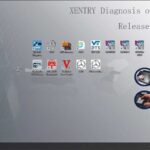Freeze Frame data in DTS Monaco offers a snapshot of crucial parameters when a fault code is triggered, aiding technicians in efficient vehicle diagnostics and car coding. DTS-MONACO.EDU.VN provides comprehensive insights into utilizing this powerful feature for accurate troubleshooting. Understanding Freeze Frame details is essential for advanced diagnostics, car electronic repairs and ECU programming.
Contents
- 1. Understanding Freeze Frame Data in DTS Monaco
- 1.1. Key Components of Freeze Frame Data
- 1.2. Importance of Freeze Frame Data
- 2. Accessing Freeze Frame Data in DTS Monaco
- 2.1. Step-by-Step Guide to Accessing Freeze Frame Data
- 2.2. Navigating the DTS Monaco Interface for Freeze Frame Data
- 3. Interpreting Freeze Frame Data Effectively
- 3.1. Analyzing Common Parameters
- 3.2. Case Studies: Real-World Examples
- Case Study 1: Misfire Under Load
- Case Study 2: Overheating at Idle
- Case Study 3: Oxygen Sensor Issue
- 4. Common Mistakes to Avoid When Using Freeze Frame Data
- 4.1. Overlooking Related Symptoms
- 4.2. Ignoring the Context of the Data
- 4.3. Neglecting Regular Software Updates
- 5. Advanced Techniques for Freeze Frame Analysis
- 5.1. Comparing Multiple Freeze Frames
- 5.2. Using Freeze Frame Data with Other Diagnostic Tools
- 5.3. Identifying Root Causes with Freeze Frame Data
- 6. Enhancing Your Car Coding Skills with DTS-MONACO.EDU.VN
- 6.1. Comprehensive Training Programs
- 6.2. Expert Support and Resources
- 6.3. Staying Updated with the Latest Technologies
- 7. Practical Applications of Freeze Frame Data
- 7.1. Diagnosing Intermittent Issues
- 7.2. Verifying Repairs
- 7.3. Performance Tuning
- 8. The Future of Freeze Frame Technology
- 8.1. Integration with AI and Machine Learning
- 8.2. Enhanced Data Resolution and Sampling Rates
- 8.3. Remote Diagnostics and Telematics
- 9. Freeze Frame Data and OBD-II Standards
- 9.1. Standardized Parameters
- 9.2. Compliance and Regulations
- 9.3. Accessing OBD-II Data
- 10. Maximizing Your Diagnostic Efficiency with DTS Monaco
- 10.1. Streamlining Diagnostic Procedures
- 10.2. Advanced Coding and Programming
- 10.3. Integration with Other Tools
- FAQ: Freeze Frame Data in DTS Monaco
- 1. What exactly is Freeze Frame data?
- 2. How do I access Freeze Frame data in DTS Monaco?
- 3. What are the most important parameters to analyze in Freeze Frame data?
- 4. Can Freeze Frame data help diagnose intermittent issues?
- 5. What common mistakes should I avoid when using Freeze Frame data?
- 6. How can Freeze Frame data be used with other diagnostic tools?
- 7. How does DTS-MONACO.EDU.VN help in mastering Freeze Frame analysis?
- 8. Is Freeze Frame data part of the OBD-II standards?
- 9. Can Freeze Frame data be used to verify repairs?
- 10. What is the future of Freeze Frame technology?
1. Understanding Freeze Frame Data in DTS Monaco
Freeze Frame data within DTS Monaco captures specific parameter values at the moment a Diagnostic Trouble Code (DTC) is registered. This information provides vital clues about the conditions under which the fault occurred, thereby assisting technicians in diagnosing the root cause of the problem more effectively. Understanding this data is critical for technicians aiming to enhance their diagnostic skills and offer superior car coding services.
Freeze Frame data is essentially a snapshot of vehicle data recorded at the moment a fault occurs. This snapshot contains a wealth of information that can help technicians understand the conditions that led to the fault, making it easier to diagnose and repair the problem. DTS Monaco is a powerful diagnostic tool that allows technicians to access and interpret this data effectively. By understanding Freeze Frame data, technicians can improve their diagnostic accuracy and efficiency, leading to better service and customer satisfaction.
1.1. Key Components of Freeze Frame Data
So, what data points are typically included in a Freeze Frame? Let’s explore the common parameters:
- Fault Code (DTC): The specific Diagnostic Trouble Code that triggered the Freeze Frame.
- Engine Speed (RPM): Revolutions per minute of the engine at the time of the fault.
- Vehicle Speed: The speed of the vehicle when the fault occurred.
- Engine Load: Percentage of maximum engine load.
- Coolant Temperature: Temperature of the engine coolant.
- Fuel Trim: Adjustments made to the air-fuel mixture.
- Intake Air Temperature (IAT): Temperature of the air entering the engine.
- Mass Air Flow (MAF): The amount of air entering the engine.
- Throttle Position: Percentage of throttle opening.
- Fuel Rail Pressure: Pressure of the fuel in the fuel rail.
- Ignition Timing Advance: The amount of ignition timing advance.
- Battery Voltage: Voltage of the vehicle’s battery.
- Oxygen Sensor Readings: Readings from the oxygen sensors in the exhaust system.
- System Status: The status of the vehicle’s systems, such as open loop or closed loop.
- Time Since Engine Start: The amount of time the engine has been running since it was started.
According to the National Institute for Automotive Service Excellence (ASE), proficiency in interpreting Freeze Frame data is a hallmark of skilled automotive technicians.
1.2. Importance of Freeze Frame Data
Freeze Frame data plays a pivotal role in automotive diagnostics. It provides a historical record of the conditions present when a fault code was set, which can significantly reduce diagnostic time. Without this data, technicians often have to rely on recreating the fault, which can be time-consuming and challenging. With Freeze Frame data, technicians can quickly identify the conditions that triggered the fault and focus their diagnostic efforts accordingly. This leads to faster and more accurate diagnoses, ultimately improving the efficiency and quality of automotive repairs.
Freeze Frame data helps in:
- Faster Diagnostics: Quickly identify the conditions that caused the fault.
- Accurate Troubleshooting: Pinpoint the root cause of the problem.
- Reduced Downtime: Minimize the time needed to repair the vehicle.
- Improved Customer Satisfaction: Provide more effective and efficient service.
2. Accessing Freeze Frame Data in DTS Monaco
DTS Monaco simplifies the process of accessing and interpreting Freeze Frame data. The software provides a user-friendly interface that allows technicians to quickly retrieve and analyze the data. With DTS Monaco, technicians can easily view the Freeze Frame data associated with each DTC, providing valuable insights into the conditions that led to the fault. This makes the diagnostic process more efficient and accurate, ultimately saving time and improving the quality of automotive repairs.
2.1. Step-by-Step Guide to Accessing Freeze Frame Data
Here’s a detailed guide on how to access Freeze Frame data using DTS Monaco:
- Connect to the Vehicle: Establish a connection between DTS Monaco and the vehicle’s ECU (Electronic Control Unit).
- Select the ECU: Choose the specific ECU you want to diagnose from the list of available ECUs.
- Read Fault Codes: Use DTS Monaco to read and display any stored Diagnostic Trouble Codes (DTCs).
- Access Freeze Frame Data: For each DTC, there should be an option to view the Freeze Frame data associated with it. This option is typically found in the DTC details or related information section.
- Analyze the Data: Examine the various parameters recorded in the Freeze Frame, such as engine speed, vehicle speed, coolant temperature, and fuel trim.
- Interpret the Findings: Use the Freeze Frame data to understand the conditions under which the fault occurred and identify potential causes.
2.2. Navigating the DTS Monaco Interface for Freeze Frame Data
The DTS Monaco interface is designed to make accessing and interpreting Freeze Frame data as intuitive as possible. Once you have connected to the vehicle and read the fault codes, you can easily access the Freeze Frame data by selecting the DTC of interest. The Freeze Frame data is typically displayed in a table or list format, with each parameter and its corresponding value clearly labeled. DTS Monaco also provides tools for analyzing the data, such as graphing and filtering, which can help technicians identify patterns and trends. By mastering the DTS Monaco interface, technicians can quickly and efficiently access the information they need to diagnose automotive faults.
Key areas to navigate include:
- DTC Display: The section where Diagnostic Trouble Codes are listed.
- DTC Details: Area providing specific information about a selected DTC, including Freeze Frame data.
- Parameter Identification: Clearly labeled parameters such as engine speed, vehicle speed, and temperature readings.
- Data Analysis Tools: Features to graph, filter, and analyze Freeze Frame data.
3. Interpreting Freeze Frame Data Effectively
Interpreting Freeze Frame data effectively is crucial for accurate diagnostics. By carefully analyzing the data and understanding the relationships between different parameters, technicians can gain valuable insights into the conditions that led to the fault. This information can then be used to pinpoint the root cause of the problem and develop an effective repair strategy. Proper interpretation of Freeze Frame data requires a solid understanding of automotive systems and how they interact, as well as familiarity with the specific characteristics of the vehicle being diagnosed.
3.1. Analyzing Common Parameters
To effectively interpret Freeze Frame data, focus on analyzing the most common parameters:
- Engine Speed (RPM): High RPMs during a fault might indicate issues related to acceleration or high-speed operation.
- Vehicle Speed: Knowing the vehicle speed at the time of the fault can help determine if the issue is speed-related.
- Engine Load: High engine load can point to problems under heavy acceleration or uphill driving.
- Coolant Temperature: Overheating or unusually low temperatures can indicate cooling system issues.
- Fuel Trim: Extreme positive or negative fuel trim values can suggest fuel system or air intake problems.
- Oxygen Sensor Readings: Abnormal readings can indicate issues with the oxygen sensors or catalytic converter.
According to a study by the University of Michigan Transportation Research Institute, analyzing these parameters in conjunction can significantly improve diagnostic accuracy.
3.2. Case Studies: Real-World Examples
Let’s consider a few real-world case studies to illustrate how Freeze Frame data can be used to diagnose automotive problems:
Case Study 1: Misfire Under Load
A vehicle experiences a misfire under heavy acceleration. The Freeze Frame data shows:
- DTC: P0300 (Random Misfire Detected)
- Engine Speed: 3500 RPM
- Vehicle Speed: 55 mph
- Engine Load: 85%
- Fuel Trim: +20%
Interpretation: The high engine load and positive fuel trim suggest that the engine is running lean under acceleration. This could be due to a faulty fuel injector, a vacuum leak, or a problem with the mass airflow sensor.
Case Study 2: Overheating at Idle
A vehicle overheats while idling. The Freeze Frame data shows:
- DTC: P0128 (Coolant Thermostat Below Regulating Temperature)
- Engine Speed: 800 RPM
- Vehicle Speed: 0 mph
- Coolant Temperature: 170°F
Interpretation: The low coolant temperature at idle suggests that the thermostat is stuck open, preventing the engine from reaching its normal operating temperature.
Case Study 3: Oxygen Sensor Issue
A vehicle has an oxygen sensor fault. The Freeze Frame data shows:
- DTC: P0135 (O2 Sensor Heater Circuit Malfunction (Bank 1, Sensor 1))
- Engine Speed: 2000 RPM
- Vehicle Speed: 30 mph
- Oxygen Sensor Readings: 0.1V
Interpretation: The low voltage reading from the oxygen sensor indicates a potential issue with the sensor itself or the heater circuit. This could be due to a faulty sensor, a wiring problem, or a blown fuse.
4. Common Mistakes to Avoid When Using Freeze Frame Data
Even with powerful tools like DTS Monaco, it’s important to avoid common mistakes when using Freeze Frame data. Misinterpreting the data or overlooking crucial details can lead to inaccurate diagnoses and wasted time. By being aware of these common pitfalls, technicians can improve their diagnostic accuracy and avoid costly errors.
4.1. Overlooking Related Symptoms
Relying solely on Freeze Frame data without considering other symptoms can be misleading. Always consider the complete picture, including the customer’s description of the problem, any other symptoms the vehicle is exhibiting, and the vehicle’s service history. Ignoring these factors can lead to a misdiagnosis and an ineffective repair.
For example, if a customer reports that the vehicle is experiencing a loss of power and the Freeze Frame data indicates a problem with the fuel system, it’s important to also check for other symptoms such as unusual noises, vibrations, or smoke. These additional symptoms can provide valuable clues about the nature of the problem and help to narrow down the possible causes.
4.2. Ignoring the Context of the Data
Failing to consider the context in which the Freeze Frame data was recorded can also lead to misinterpretations. For example, if the Freeze Frame data was recorded during a cold start, some parameters may be outside of their normal ranges. It’s important to understand the conditions under which the data was recorded and to interpret the data accordingly.
Additionally, it’s important to consider the specific characteristics of the vehicle being diagnosed. Different vehicles may have different normal ranges for certain parameters, and what is considered normal for one vehicle may be abnormal for another. By understanding the specific characteristics of the vehicle and the conditions under which the data was recorded, technicians can avoid misinterpreting the Freeze Frame data and make more accurate diagnoses.
4.3. Neglecting Regular Software Updates
Using outdated software can result in inaccurate data or missing features. Regularly update your DTS Monaco software to ensure you have the latest diagnostic capabilities and accurate information. Software updates often include improvements to the accuracy and reliability of Freeze Frame data, as well as new features and diagnostic capabilities. By keeping your software up to date, you can ensure that you are using the most accurate and effective tools available.
5. Advanced Techniques for Freeze Frame Analysis
For technicians seeking to elevate their diagnostic skills, mastering advanced Freeze Frame analysis techniques is essential. These techniques involve using more sophisticated methods to interpret the data and identify complex problems. By incorporating these advanced techniques into their diagnostic process, technicians can improve their accuracy and efficiency, leading to better service and customer satisfaction.
5.1. Comparing Multiple Freeze Frames
When diagnosing intermittent issues, comparing Freeze Frame data from multiple occurrences can reveal patterns. Look for consistent values or trends that may indicate the underlying problem. By comparing multiple Freeze Frames, technicians can gain a more complete picture of the conditions that are causing the fault and identify subtle patterns that might be missed when analyzing a single Freeze Frame.
For example, if a vehicle is experiencing an intermittent misfire, comparing Freeze Frame data from multiple misfire events can reveal that the misfires are always occurring under the same conditions, such as high engine load or during a specific driving maneuver. This information can help to narrow down the possible causes of the misfire and make the diagnostic process more efficient.
5.2. Using Freeze Frame Data with Other Diagnostic Tools
Combine Freeze Frame data with other diagnostic tools, such as oscilloscopes and multimeters, to gain a more comprehensive understanding of the problem. For example, you might use an oscilloscope to examine the waveforms of the oxygen sensors while monitoring the Freeze Frame data to see how the sensor readings are changing under different conditions. By combining Freeze Frame data with other diagnostic tools, technicians can gain a more complete and accurate understanding of the problem and develop an effective repair strategy.
5.3. Identifying Root Causes with Freeze Frame Data
Freeze Frame data can be invaluable in identifying the root causes of complex automotive problems. By carefully analyzing the data and considering the context in which it was recorded, technicians can often pinpoint the underlying cause of the fault. This can save time and effort in the diagnostic process and lead to more effective repairs.
For example, if a vehicle is experiencing a drivability problem and the Freeze Frame data indicates a problem with the fuel system, the technician can use the Freeze Frame data to narrow down the possible causes of the problem. By analyzing the fuel trim values, oxygen sensor readings, and other parameters, the technician can often determine whether the problem is due to a faulty fuel injector, a vacuum leak, or a problem with the mass airflow sensor. This information can then be used to develop an effective repair strategy and resolve the problem quickly and efficiently.
6. Enhancing Your Car Coding Skills with DTS-MONACO.EDU.VN
To truly master the art of automotive diagnostics and car coding, turn to DTS-MONACO.EDU.VN. We provide comprehensive training and resources to help you excel in using DTS Monaco and other advanced diagnostic tools. Our courses are designed to equip you with the skills and knowledge you need to tackle even the most challenging automotive problems.
6.1. Comprehensive Training Programs
DTS-MONACO.EDU.VN offers a range of training programs designed to help you master the use of DTS Monaco and other advanced diagnostic tools. Our courses cover everything from the basics of vehicle diagnostics to advanced car coding techniques. Whether you are a novice technician or an experienced professional, we have a course that is right for you.
Our training programs are taught by experienced instructors who are experts in the field of automotive diagnostics and car coding. They will guide you through the process of using DTS Monaco and other diagnostic tools, and will provide you with the hands-on experience you need to succeed.
6.2. Expert Support and Resources
At DTS-MONACO.EDU.VN, we are committed to providing you with the support and resources you need to succeed. We offer a range of resources, including online tutorials, technical documentation, and a comprehensive knowledge base. We also provide expert support to help you with any questions or problems you may encounter.
Our online tutorials cover a wide range of topics, from the basics of vehicle diagnostics to advanced car coding techniques. Our technical documentation provides detailed information about the use of DTS Monaco and other diagnostic tools. Our knowledge base contains answers to frequently asked questions and troubleshooting tips.
6.3. Staying Updated with the Latest Technologies
The automotive industry is constantly evolving, and it’s important to stay up-to-date with the latest technologies. DTS-MONACO.EDU.VN provides you with the information and resources you need to stay ahead of the curve. We regularly update our training programs and resources to reflect the latest advancements in the field of automotive diagnostics and car coding.
We also provide you with access to a network of experts who can help you stay informed about the latest trends and developments in the automotive industry. Our network includes experienced technicians, engineers, and researchers who are at the forefront of automotive technology.
7. Practical Applications of Freeze Frame Data
Understanding Freeze Frame data opens doors to numerous practical applications in automotive diagnostics and repair. By leveraging this information effectively, technicians can enhance their service offerings and improve customer satisfaction. The practical applications of Freeze Frame data are vast and varied, and by mastering these applications, technicians can become more valuable to their customers and employers.
7.1. Diagnosing Intermittent Issues
Intermittent issues can be particularly challenging to diagnose. Freeze Frame data can help by providing a snapshot of the conditions present when the issue occurred. By analyzing the Freeze Frame data, technicians can often identify the underlying cause of the problem and develop an effective repair strategy. Freeze Frame data can be used to identify patterns and trends that might be missed when analyzing a single occurrence of the problem.
7.2. Verifying Repairs
After performing a repair, Freeze Frame data can be used to verify that the repair was effective. By comparing the Freeze Frame data before and after the repair, technicians can ensure that the problem has been resolved and that the vehicle is operating properly. This can help to prevent comebacks and improve customer satisfaction.
7.3. Performance Tuning
Freeze Frame data can also be used for performance tuning. By analyzing the Freeze Frame data under different operating conditions, technicians can identify areas where the engine is not performing optimally. This information can then be used to make adjustments to the engine’s parameters, such as fuel injection timing and ignition timing, to improve performance.
8. The Future of Freeze Frame Technology
The future of Freeze Frame technology is bright, with ongoing advancements promising even more detailed and useful data for automotive technicians. As vehicles become more complex and sophisticated, the need for advanced diagnostic tools like DTS Monaco will only continue to grow. By staying up-to-date with the latest advancements in Freeze Frame technology, technicians can ensure that they are well-equipped to diagnose and repair even the most challenging automotive problems.
8.1. Integration with AI and Machine Learning
The integration of AI (Artificial Intelligence) and machine learning technologies with Freeze Frame data is set to revolutionize automotive diagnostics. AI algorithms can analyze large amounts of Freeze Frame data to identify patterns and trends that would be impossible for a human technician to detect. This can lead to faster and more accurate diagnoses, as well as the ability to predict potential problems before they occur.
Machine learning can also be used to personalize diagnostic recommendations based on the specific characteristics of the vehicle being diagnosed. By analyzing data from similar vehicles, machine learning algorithms can identify the most likely causes of the problem and recommend the most effective repair strategies.
8.2. Enhanced Data Resolution and Sampling Rates
Future Freeze Frame systems will likely feature enhanced data resolution and sampling rates, providing even more detailed information about the conditions present when a fault occurred. Higher data resolution will allow technicians to see finer details in the Freeze Frame data, while higher sampling rates will capture more data points over a shorter period of time. This will enable technicians to diagnose problems with greater precision and accuracy.
8.3. Remote Diagnostics and Telematics
Remote diagnostics and telematics are becoming increasingly common in the automotive industry. Freeze Frame data can be transmitted remotely to a technician, allowing them to diagnose problems without having to physically inspect the vehicle. This can save time and money, and can also improve customer satisfaction. Telematics systems can also be used to proactively monitor the health of the vehicle and alert the driver to potential problems before they occur.
9. Freeze Frame Data and OBD-II Standards
Freeze Frame data is an integral part of the On-Board Diagnostics II (OBD-II) standards, which mandate that all vehicles sold in the United States must provide standardized diagnostic information. Understanding the relationship between Freeze Frame data and OBD-II standards is crucial for technicians working on modern vehicles. The OBD-II standards ensure that Freeze Frame data is consistent and reliable, making it easier for technicians to diagnose problems across different makes and models.
9.1. Standardized Parameters
The OBD-II standards define a set of standardized parameters that must be included in Freeze Frame data. These parameters include engine speed, vehicle speed, engine load, coolant temperature, and fuel trim. By standardizing these parameters, the OBD-II standards ensure that technicians can easily compare Freeze Frame data from different vehicles and identify common problems.
9.2. Compliance and Regulations
Compliance with OBD-II standards is mandatory for all vehicle manufacturers selling vehicles in the United States. The Environmental Protection Agency (EPA) is responsible for enforcing these standards and ensuring that vehicle manufacturers are providing accurate and reliable diagnostic information. Failure to comply with OBD-II standards can result in significant penalties.
9.3. Accessing OBD-II Data
Accessing OBD-II data, including Freeze Frame data, requires a diagnostic scan tool that is compliant with the OBD-II standards. DTS Monaco is a powerful diagnostic scan tool that is fully compliant with the OBD-II standards. With DTS Monaco, technicians can easily access Freeze Frame data from a wide range of vehicles and use this information to diagnose and repair automotive problems.
10. Maximizing Your Diagnostic Efficiency with DTS Monaco
DTS Monaco is a comprehensive diagnostic tool that can significantly enhance your diagnostic efficiency. By mastering the use of DTS Monaco, technicians can diagnose and repair automotive problems more quickly and accurately. DTS Monaco provides a wide range of features and capabilities, including the ability to access Freeze Frame data, perform advanced coding and programming, and diagnose complex electronic systems.
10.1. Streamlining Diagnostic Procedures
DTS Monaco streamlines diagnostic procedures by providing a user-friendly interface and a wide range of diagnostic tools. With DTS Monaco, technicians can quickly access the information they need to diagnose and repair automotive problems. DTS Monaco also provides a range of automated diagnostic procedures that can save time and effort.
10.2. Advanced Coding and Programming
DTS Monaco provides advanced coding and programming capabilities that allow technicians to customize vehicle settings and parameters. This can be useful for a variety of purposes, such as improving performance, adding new features, or resolving software glitches. DTS Monaco also provides a range of security features to protect against unauthorized access and modifications.
10.3. Integration with Other Tools
DTS Monaco can be integrated with other diagnostic tools, such as oscilloscopes and multimeters, to provide a more comprehensive diagnostic solution. By integrating DTS Monaco with other tools, technicians can gain a more complete and accurate understanding of the problem and develop an effective repair strategy. DTS Monaco also supports a wide range of communication protocols, making it compatible with a variety of vehicles and diagnostic systems.
Are you ready to elevate your automotive diagnostic skills? Visit DTS-MONACO.EDU.VN today to explore our training programs, software, and expert support. Unlock the full potential of DTS Monaco and become a leader in car coding and diagnostics. Contact us at Whatsapp: +1 (641) 206-8880 or visit our location at 275 N Harrison St, Chandler, AZ 85225, United States.
FAQ: Freeze Frame Data in DTS Monaco
1. What exactly is Freeze Frame data?
Freeze Frame data is a snapshot of vehicle parameters recorded when a Diagnostic Trouble Code (DTC) is triggered. It provides details like engine speed, vehicle speed, and temperature at the time of the fault.
2. How do I access Freeze Frame data in DTS Monaco?
Connect to the vehicle’s ECU, select the ECU you want to diagnose, read the fault codes, and then access the Freeze Frame data associated with each DTC.
3. What are the most important parameters to analyze in Freeze Frame data?
Key parameters include engine speed (RPM), vehicle speed, engine load, coolant temperature, fuel trim, and oxygen sensor readings.
4. Can Freeze Frame data help diagnose intermittent issues?
Yes, comparing Freeze Frame data from multiple occurrences of an intermittent issue can reveal patterns and help identify the underlying problem.
5. What common mistakes should I avoid when using Freeze Frame data?
Avoid relying solely on Freeze Frame data, ignoring the context of the data, and neglecting regular software updates for DTS Monaco.
6. How can Freeze Frame data be used with other diagnostic tools?
Combine Freeze Frame data with tools like oscilloscopes and multimeters for a more comprehensive understanding of the problem.
7. How does DTS-MONACO.EDU.VN help in mastering Freeze Frame analysis?
DTS-MONACO.EDU.VN offers comprehensive training programs, expert support, and resources to help you excel in using DTS Monaco and other advanced diagnostic tools.
8. Is Freeze Frame data part of the OBD-II standards?
Yes, Freeze Frame data is an integral part of the On-Board Diagnostics II (OBD-II) standards, ensuring standardized diagnostic information across vehicles.
9. Can Freeze Frame data be used to verify repairs?
Yes, comparing Freeze Frame data before and after a repair can verify that the repair was effective and the problem has been resolved.
10. What is the future of Freeze Frame technology?
The future includes integration with AI and machine learning, enhanced data resolution, and remote diagnostics through telematics, making it an even more powerful tool for automotive technicians.
 Automotive Diagnostic Tool Interface Showing Freeze Frame Data
Automotive Diagnostic Tool Interface Showing Freeze Frame Data
 DTS Monaco workspace highlighting the HU6 ECU for MBUX control
DTS Monaco workspace highlighting the HU6 ECU for MBUX control
 New tab creation for EZS167 ECU in DTS Monaco
New tab creation for EZS167 ECU in DTS Monaco
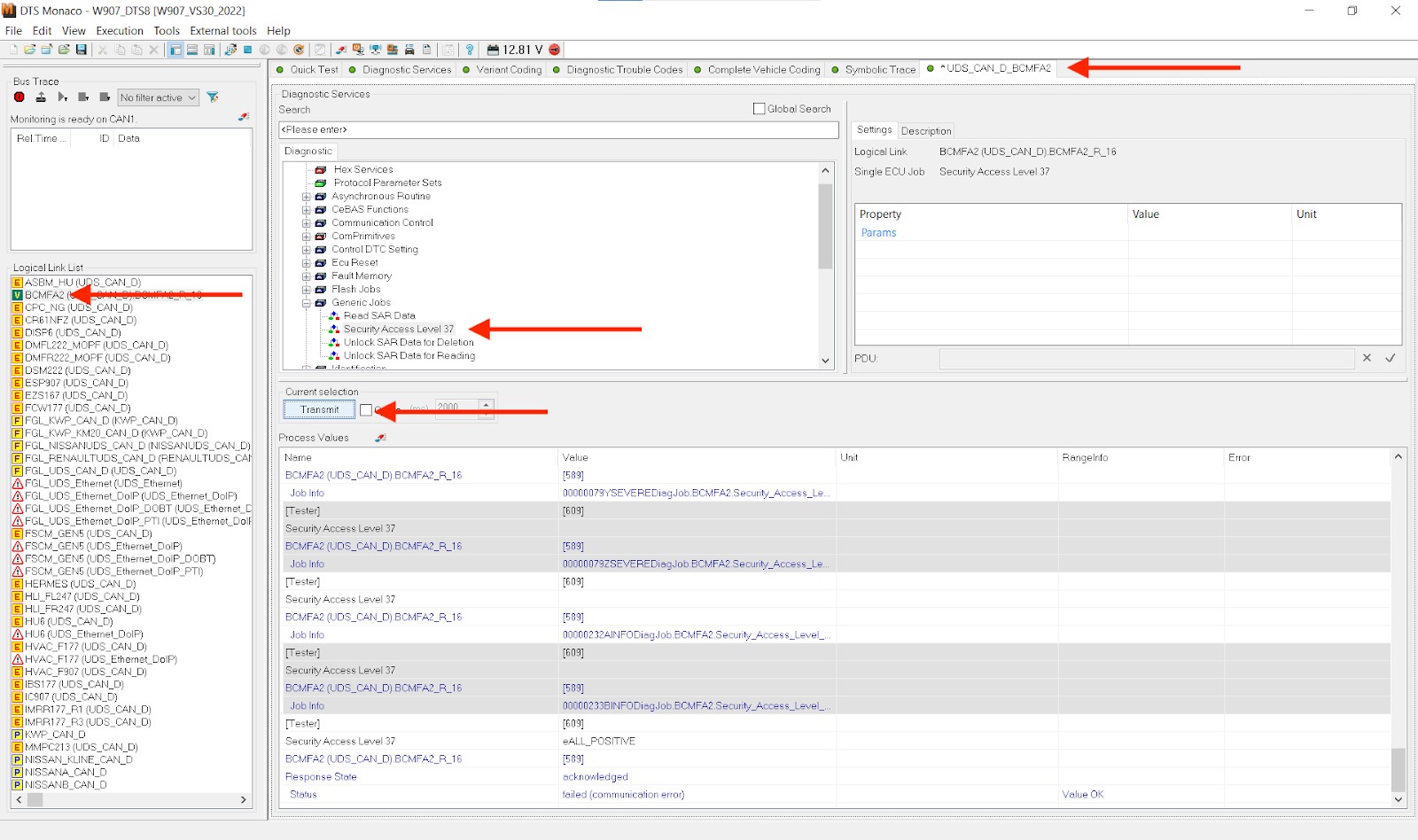 Security Access Level 37 Generic Jobs in DTS Monaco
Security Access Level 37 Generic Jobs in DTS Monaco
 Security Access Level 3B process via EZS167 ECU in DTS Monaco
Security Access Level 3B process via EZS167 ECU in DTS Monaco
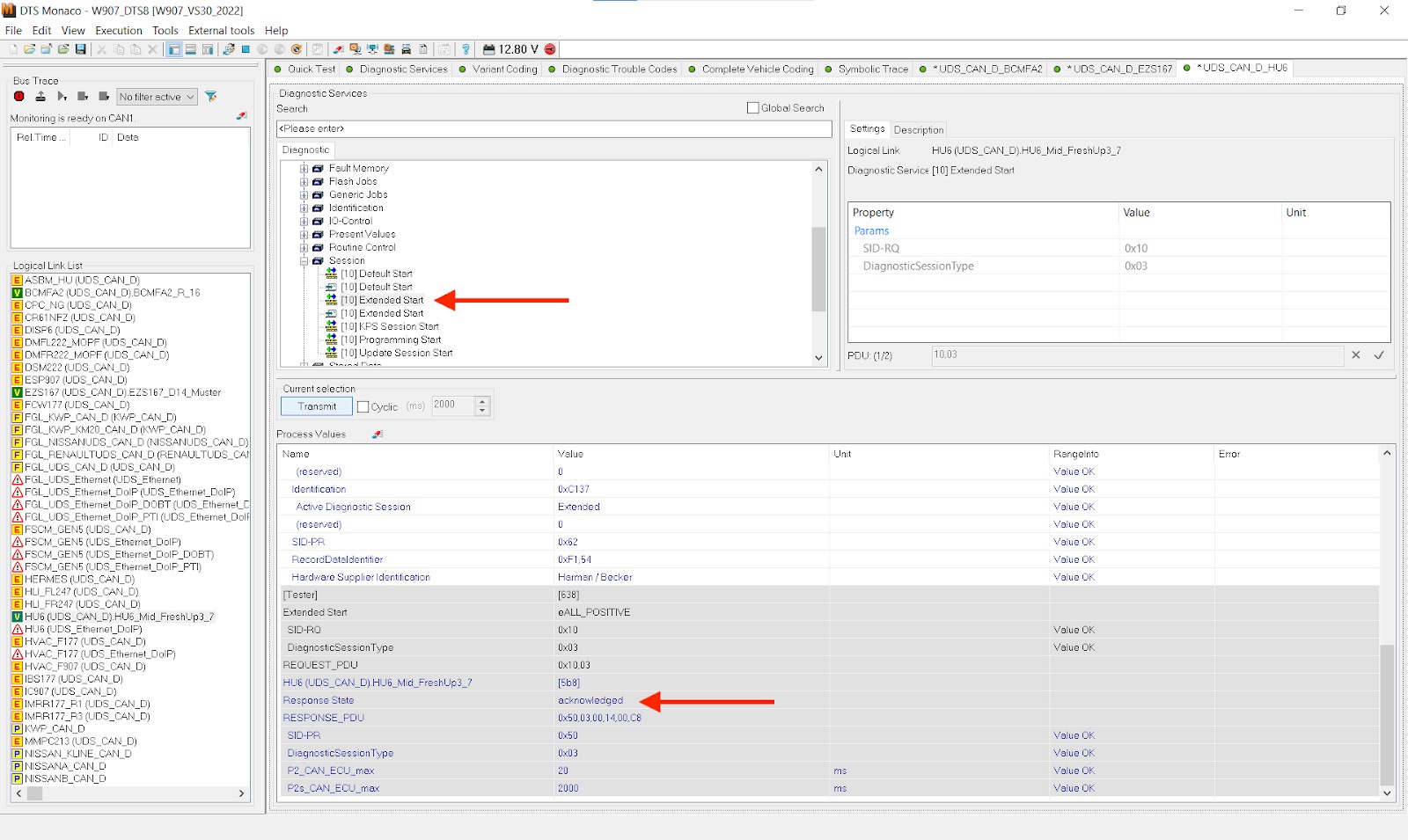 Extended Start selection and Transmit in DTS Monaco
Extended Start selection and Transmit in DTS Monaco
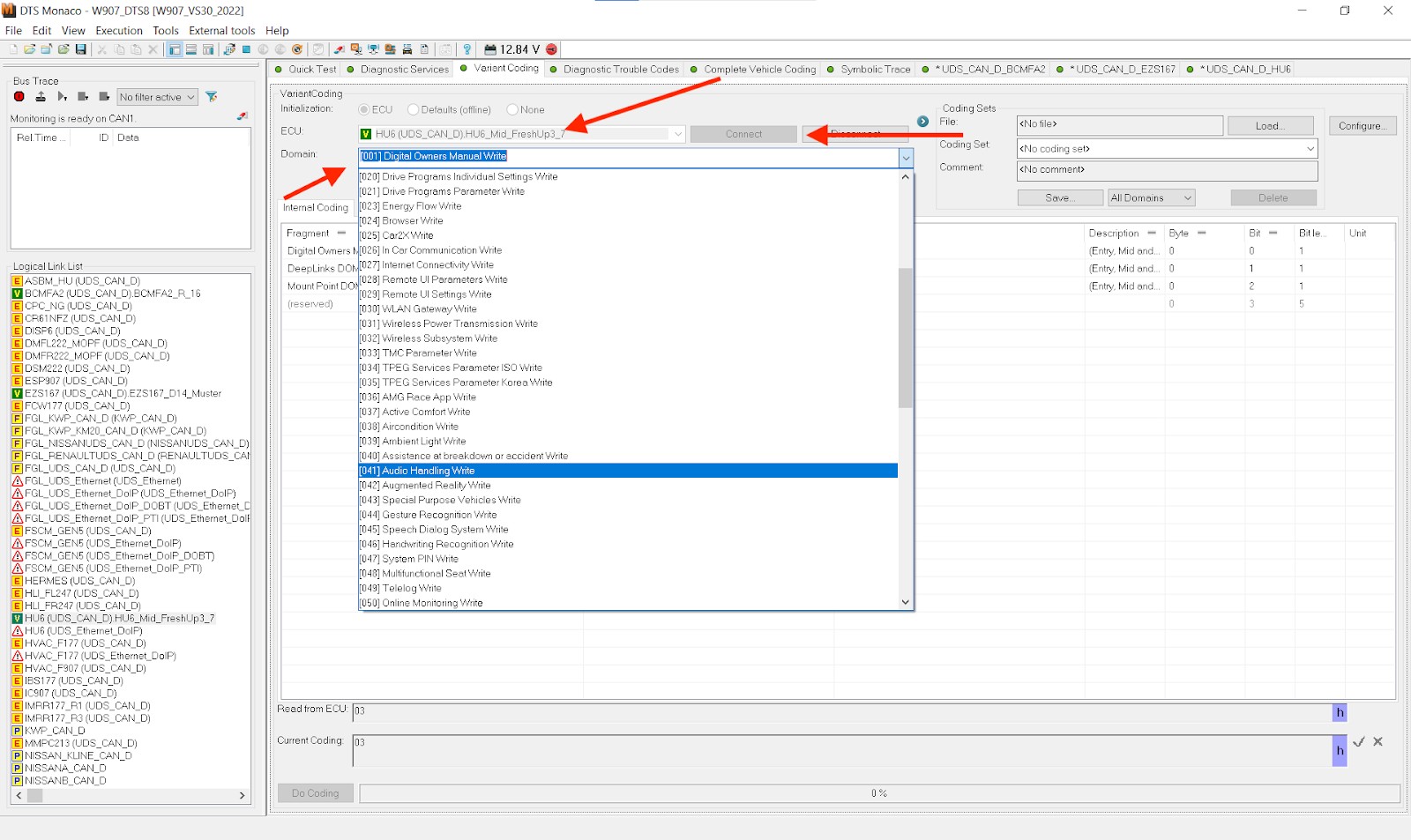 Audio Handle Write for adding fader and balance to the MBUX in DTS Monaco
Audio Handle Write for adding fader and balance to the MBUX in DTS Monaco
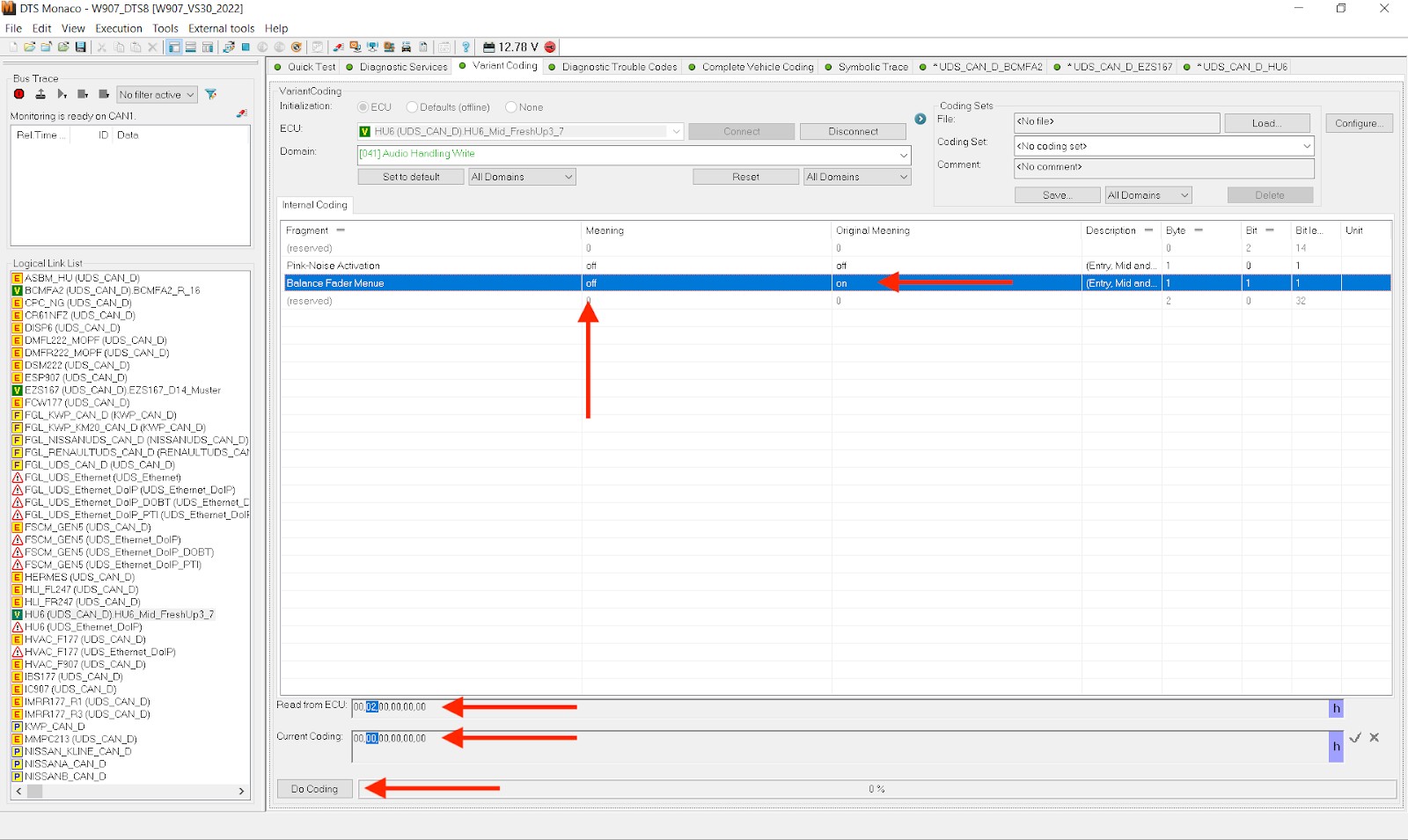 Balance Fader Menue selection in DTS Monaco
Balance Fader Menue selection in DTS Monaco
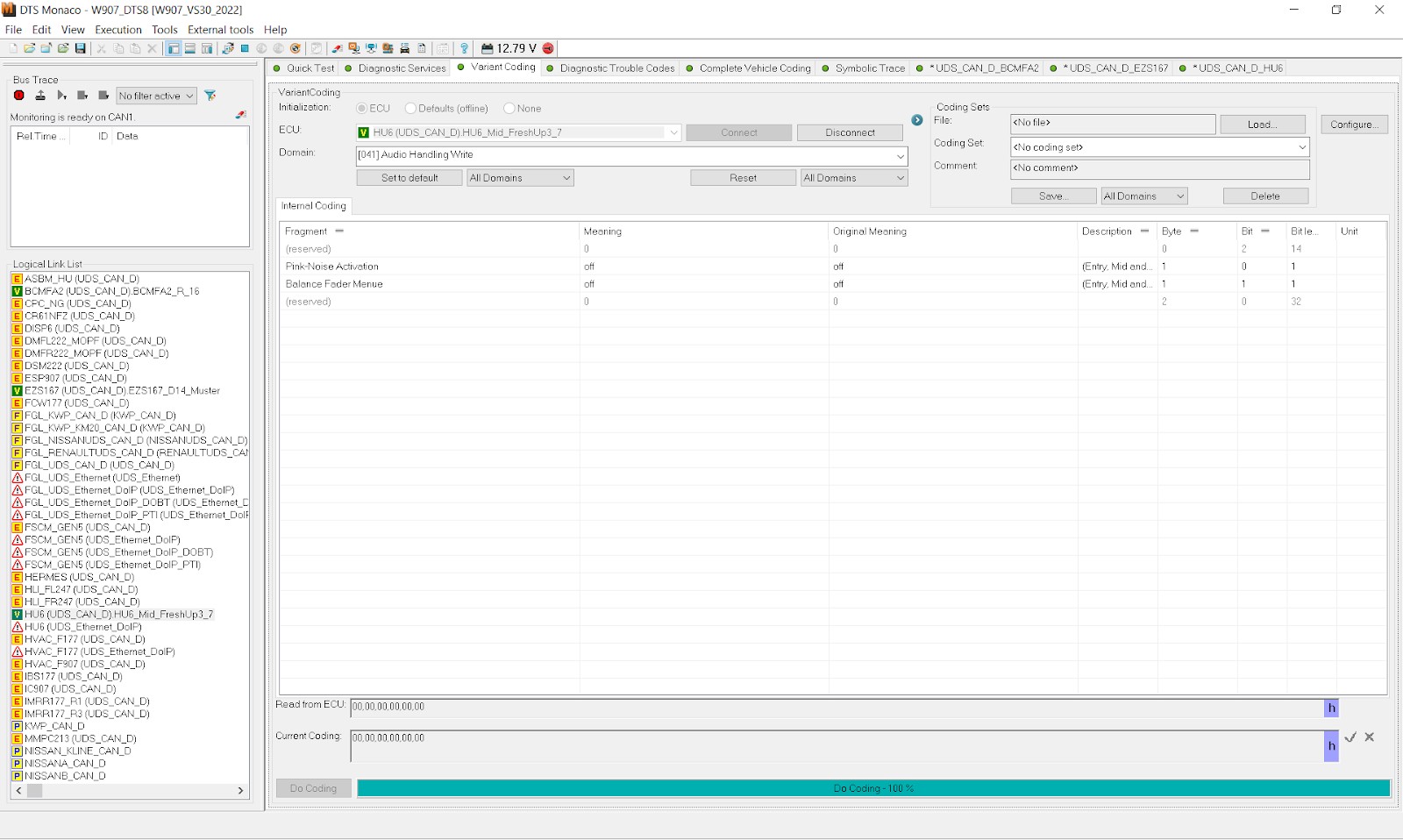 New value presentation under Meaning column and Current Coding in DTS Monaco
New value presentation under Meaning column and Current Coding in DTS Monaco
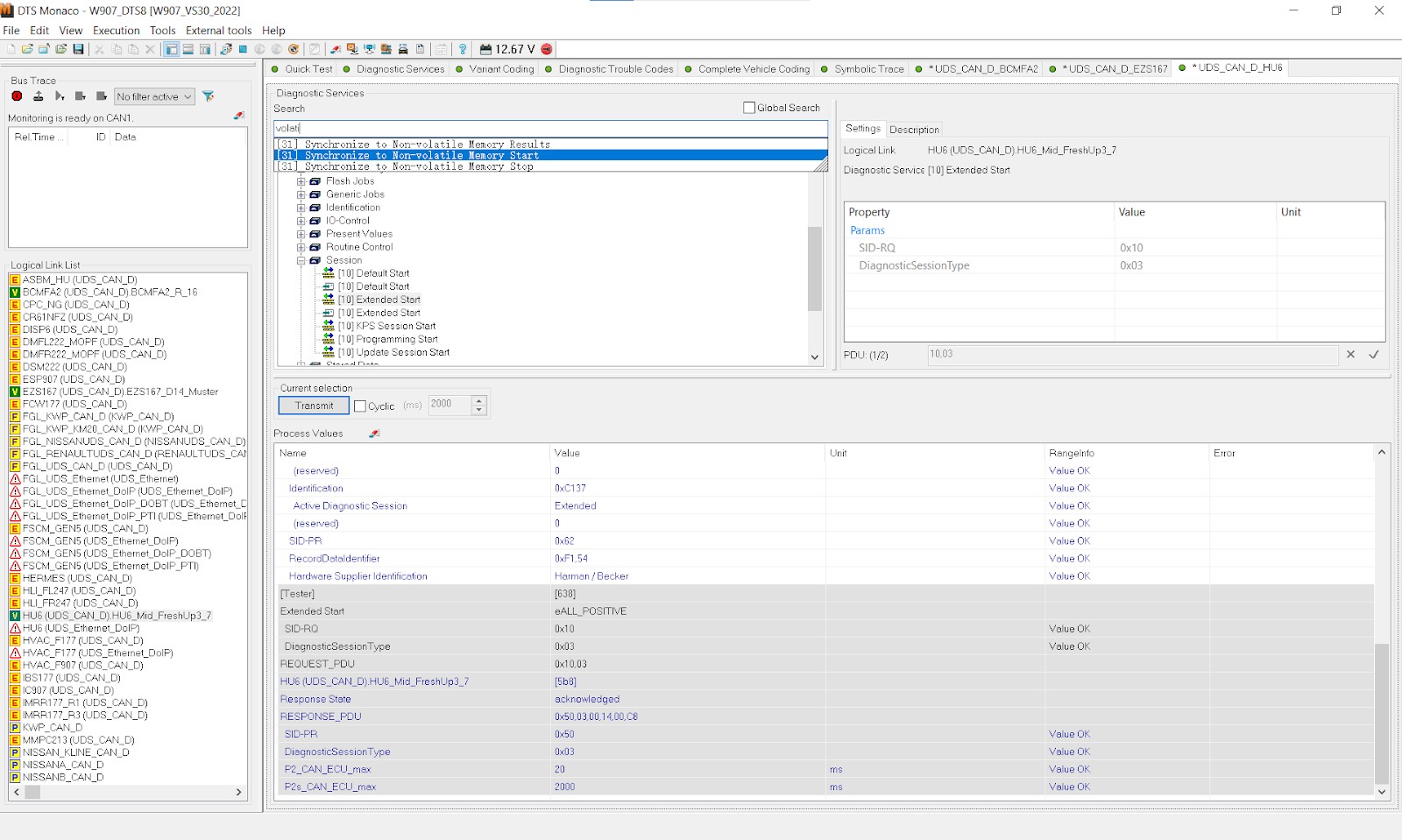 Synchronize to Non-volatile Memory Start function in DTS Monaco
Synchronize to Non-volatile Memory Start function in DTS Monaco
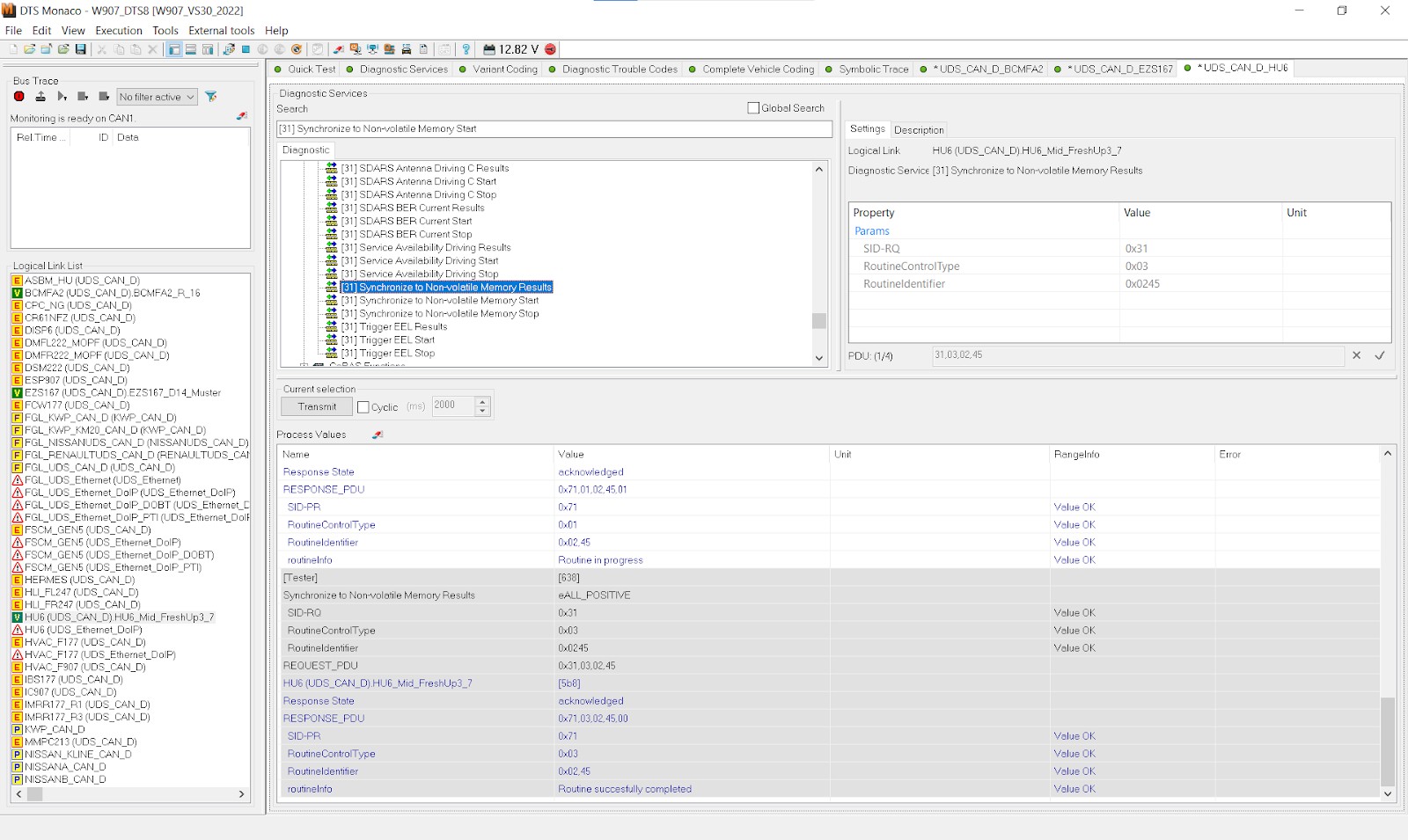 Synchronize to Non-volatile Memory Results function in DTS Monaco
Synchronize to Non-volatile Memory Results function in DTS Monaco
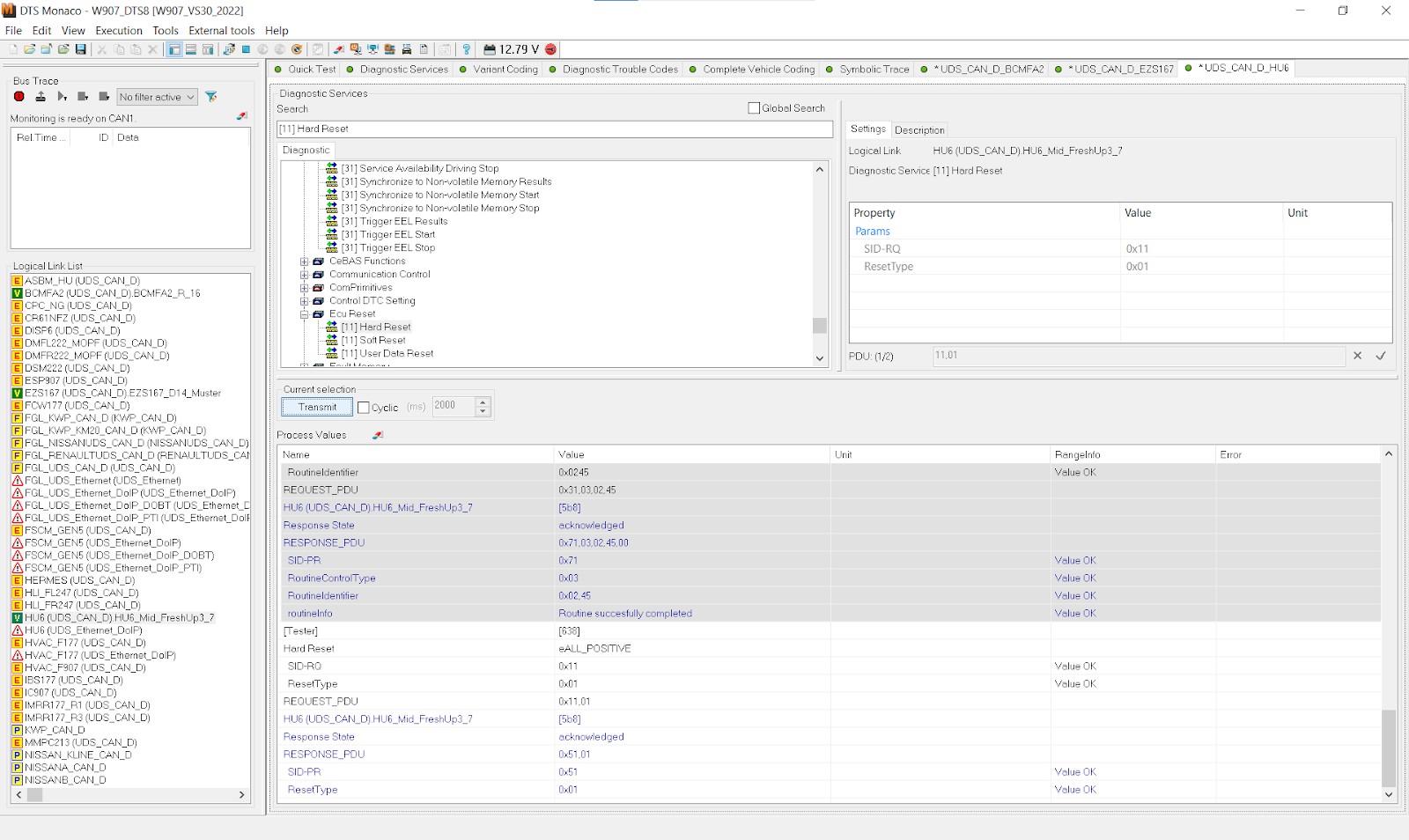 Hard Reset of the ECU process in DTS Monaco
Hard Reset of the ECU process in DTS Monaco
